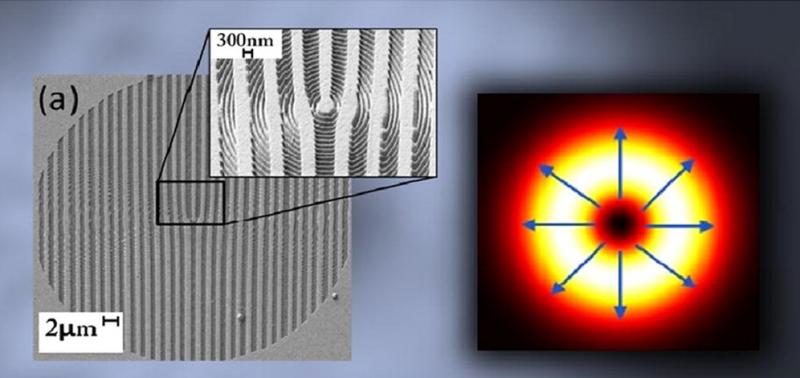
Nanostructured device controls the intensity, phase, and polarization of light for wide applications in optics
Applied physicists at the Harvard School of Engineering and Applied Sciences (SEAS) have demonstrated that they can change the intensity, phase, and polarization of light rays using a hologram-like design decorated with nanoscale structures.
As a proof of principle, the researchers have used it to create an unusual state of light called a radially polarized beam, which—because it can be focused very tightly—is important for applications like high-resolution lithography and for trapping and manipulating tiny particles like viruses.
This is the first time a single, simple device has been designed to control these three major properties of light at once. (Phase describes how two waves interfere to either strengthen or cancel each other, depending on how their crests and troughs overlap; polarization describes the direction of light vibrations; and the intensity is the brightness.)
“Our lab works on using nanotechnology to play with light,” says Patrice Genevet, a research associate at Harvard SEAS and co-lead author of a paper published this month in Nano Letters. “In this research, we’ve used holography in a novel way, incorporating cutting-edge nanotechnology in the form of subwavelength structures at a scale of just tens of nanometers.” One nanometer equals one billionth of a meter.
Genevet works in the laboratory of Federico Capasso, Robert L. Wallace Professor of Applied Physics and Vinton Hayes Senior Research Fellow in Electrical Engineering at Harvard SEAS. Capasso’s research group in recent years has focused on nanophotonics—the manipulation of light at the nanometer scale—with the goal of creating new light beams and special effects that arise from the interaction of light with nanostructured materials.
Using these novel nanostructured holograms, the Harvard researchers have converted conventional, circularly polarized laser light into radially polarized beams at wavelengths spanning the technologically important visible and near-infrared light spectrum.
“When light is radially polarized, its electromagnetic vibrations oscillate inward and outward from the center of the beam like the spokes of a wheel,” explains Capasso. “This unusual beam manifests itself as a very intense ring of light with a dark spot in the center.”
“It is noteworthy,” Capasso points out, “that the same nanostructured holographic plate can be used to create radially polarized light at so many different wavelengths. Radially polarized light can be focused much more tightly than conventionally polarized light, thus enabling many potential applications in microscopy and nanoparticle manipulation.”
The new device resembles a normal hologram grating with an additional, nanostructured pattern carved into it. Visible light, which has a wavelength in the hundreds of nanometers, interacts differently with apertures textured on the ‘nano’ scale than with those on the scale of micrometers or larger. By exploiting these behaviors, the modular interface can bend incoming light to adjust its intensity, phase, and polarization.
Holograms, beyond being a staple of science-fiction universes, find many applications in security, like the holographic panels on credit cards and passports, and new digital hologram-based data-storage methods are currently being designed to potentially replace current systems. Achieving fine-tuned control of light is critical to advancing these technologies.
“Now, you can control everything you need with just a single interface,” says Genevet, pointing out that the polarization effect the new interface has on light could formerly only be achieved by a cascade of several different optical elements. “We’re gaining a big advantage in terms of saving space.”
The Latest Bing News on:
Hologram
- Mann Ki Baat: Interrogating Modi's Political Personae & the Art of Communicationon April 28, 2024 at 12:10 am
Narendra Modi has skilfully cultivated a succession of unique political personas. Every one of these personae represents a distinct register, conveying specific values and ideas about his leadership.
- 5 Futuristic Smartphone Features That Would Be Gamechangerson April 27, 2024 at 3:15 pm
In its ideal form, this notion could let us perform all kinds of tasks with only the most minute of gestures. With a snap of your fingers, you could record a video on your phone's camera, then fire it ...
- UAE landmarks could soon be turned into hologramson April 27, 2024 at 7:22 am
Photonics is the study of light and has several applications including LED, VR, holograms, high-speed internet and solar panels among other things ...
- The Hologram Moment: Rome Odunzeon April 26, 2024 at 3:14 pm
The Chicago Bears introduced Rome Odunze to his new team's fa base in an incredible way - by having him be in two places at one time! The Bears beamed Odunze live from Detroit into the Miller Lite ...
- The Hologram Moment: Caleb Williamson April 26, 2024 at 3:14 pm
The Chicago Bears introduced Caleb Williams to his new team's fanbase in an incredible way - by having him be in two places at one time! The Bears beamed Williams live from Detroit into the Miller ...
- 32 Fake Movies Within Movies We Want To Watchon April 25, 2024 at 10:34 pm
Here’s my list of the movies within movies that I want to watch one day. In this day and age of superhero movies, what the world needs is a Bluntman and Chronic movie, right? While “Good Will Hunting ...
- Peering Into MicroCloud Hologram's Recent Short Intereston April 25, 2024 at 8:31 am
According to Benzinga Pro, MicroCloud Hologram's peer group average for short interest as a percentage of float is 2.82%, which means the company has more short interest than most of its peers. Did ...
- Hologram Market to Reach $20.1 billion, Globally, by 2032 at 21.5% CAGR: Allied Market Researchon April 24, 2024 at 1:53 am
Digital Holography Market was estimated at $5 billion in 2021 and is expected to hit $23.1 billion by 2031, registering a CAGR of 16.7% from 2022 to 2031 Holographic Display Market size was valued at ...
- Hologram version of Dolores Huerta will be the star for years to come at her Peace and Justice Cultural Centeron April 16, 2024 at 6:48 pm
A three-dimensional image of Dolores Huerta won’t merely speak to visitors at the cultural center, but answer their questions in real time.
- Celebrity-Backed Proto Puts Holograms in a Four Seasons Hotelon April 15, 2024 at 1:27 pm
Guests at the Beverly Wilshire hotel can now interact with holographic versions of staff projected into their rooms.
The Latest Google Headlines on:
Hologram
[google_news title=”” keyword=”Hologram” num_posts=”10″ blurb_length=”0″ show_thumb=”left”]
The Latest Bing News on:
Nanostructured holograms
- WiMi Hologram Cloud Inc (WIMI)on April 22, 2024 at 4:59 pm
BEIJING, March. 11, 2024 /PRNewswire/ -- WiMi Hologram Cloud Inc. (NASDAQ: WIMI) ("WiMi" or the "Company"), a leading global Hologram Augmented Reality ("AR ...
- MicroCloud Hologram Inc HOLOon April 18, 2024 at 5:00 pm
We sell different types of products and services to both investment professionals and individual investors. These products and services are usually sold through license agreements or subscriptions ...
- Celebrity-Backed Proto Puts Holograms in a Four Seasons Hotelon April 15, 2024 at 1:27 pm
At the very least, guests will remember the hotel where they talked to a hologram. Guests at a Four Seasons hotel in Beverly Hills can now access in-room concierge via hologram. The Beverly ...
- Lana Del Rey’s Coachella Hologram Has Hatsune Miku Fans Upset The Virtual Performer Didn’t Get Oneon April 12, 2024 at 5:00 pm
Coachella has once again become the site of hologram-related controversy. However, this time, rather than the unexpected (and borderline creepy) likeness of a deceased performer, the scandal is ...
- Coachella fans crowded together to watch a hologram sing. It never showed up.on April 12, 2024 at 5:00 pm
Since then Miku has toured around the world, “performing” in concert as a hologram to thousands of adoring fans. But on Friday, their beloved hologram was no hologram at all. Hatsune Miku had ...
- Miku fans wanted a hologram concert — they got a TV show insteadon April 9, 2024 at 12:49 pm
If you made it through that headline and you’re confused, don’t worry — I was, too, at first. Hatsune Miku is an internet fandom thing. She’s not a real person, and she didn’t get her ...
- Hatsune Miku Fans Left Reeling as Virtual Pop Star Appears on Screen, Not as a Hologramon April 8, 2024 at 11:35 pm
Hatsune Miku's concert tour has faced backlash after the virtual pop star appeared on a screen instead of as a hologram to perform her set. The Miku Expo 2024 North America tour kicked off at the ...
- Kiss sell music catalogue and face paint designs in huge deal with Abba hologram companyon April 4, 2024 at 6:30 am
Rock legends Kiss have sold their music catalogue, and face paint designs, to the company behind Abba’s hologram concerts. The group, known for their black and white make up and metallic outfits ...
- Bastion of artistic integrity KISS sells out to hologram firmon April 3, 2024 at 5:00 pm
Remember when Justin Timberlake performed with a giant “hologram” of Prince (it was actually just a projection on a sheet) during his 2018 Super Bowl halftime show, and everyone freaked out?
The Latest Google Headlines on:
Nanostructured holograms
[google_news title=”” keyword=”nanostructured holograms” num_posts=”10″ blurb_length=”0″ show_thumb=”left”]










